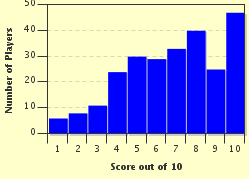Quiz Answer Key and Fun Facts
1. Science fiction is a much older genre than many give it credit for: here's a book that was first published in 1865! In the novel, three rival adventurers decide to travel to the Moon by climbing into a metal tube and firing themselves from an enormous cannon. Which author made some surprisingly accurate guesses about space travel in telling this story?
2. Many science fiction authors explore the possibilities of scientific ventures to the Moon. In one novel, associated with a famous film, the lunar crater Tycho is found to contain key evidence of extraterrestrial life and early human history. This evidence is a monolith -- an immense, smooth, magnetic black slab. What classic novel follows the consequences of this monolith's mysterious transmissions?
3. The Moon is a victim in a 1971 novel about a man whose "effective dreams" create a new reality. Urged by his psychiatrist to dream of a humanity at peace, the man does dream of peoples united -- but only in the face of an extraterrestrial attack on the Moon. Who spun this tale of dreams, reality and utopia?
4. "The First Men in the Moon" (1901) tells of a scientist and a businessman who make the first-ever voyage to the Moon -- only to be captured by the bug-like people who live underground there. Who wrote of this alarming first encounter?
5. The Moon is only a quick stopover in the classic tale of spaceman Gully Foyle's extended revenge. He visits the Moon to find an informant who works in a vast pharmaceutical factory: the lunar environment is perfect for growing anaerobic bacteria. Who wrote the novel that gave us Gully Foyle, jaunting, and a solar system ruled by feudal, corporate clans?
6. In one memorable novel, human-alien contact is achieved between universes before it can be sought between planets. The two parallel universes have slightly different values for certain fundamental physics properties; by exchanging particles across the boundary, both sides get free energy. Which science-fiction author, who only very rarely wrote anything about aliens at all, described the lunar energy station that takes advantage of this particle flow?
7. When children's author Hugh Lofting wrote about the Moon in 1928, he came up with a unique description: a vibrant wilderness where even the plants are intelligent! Which beloved character, renowned for his ability to speak to animals, extends his communication skills to lunar plants?
8. "An Inconstant Moon" may be beautiful, but it's a bad omen for Earth. What writer ventured from Known Space to tell this short story much closer to home?
9. With place names like the Sea of Tranquility, the Moon seems like a peaceful place, but science fiction tells a different tale. In one author's telling, the Moon is settled as a penal colony, and one day its residents rise up against Earth. Which of these writers insisted that "there ain't no such thing as a free lunch"?
10. Ray Bradbury's short story "-- And the Moon Be Still as Bright" may be set on Mars, but the Moon of the title gives it an elegiac flavor that helps define the story. The title comes from the works of which Romantic poet?
Source: Author
CellarDoor
This quiz was reviewed by FunTrivia editor
agony before going online.
Any errors found in FunTrivia content are routinely corrected through our feedback system.

